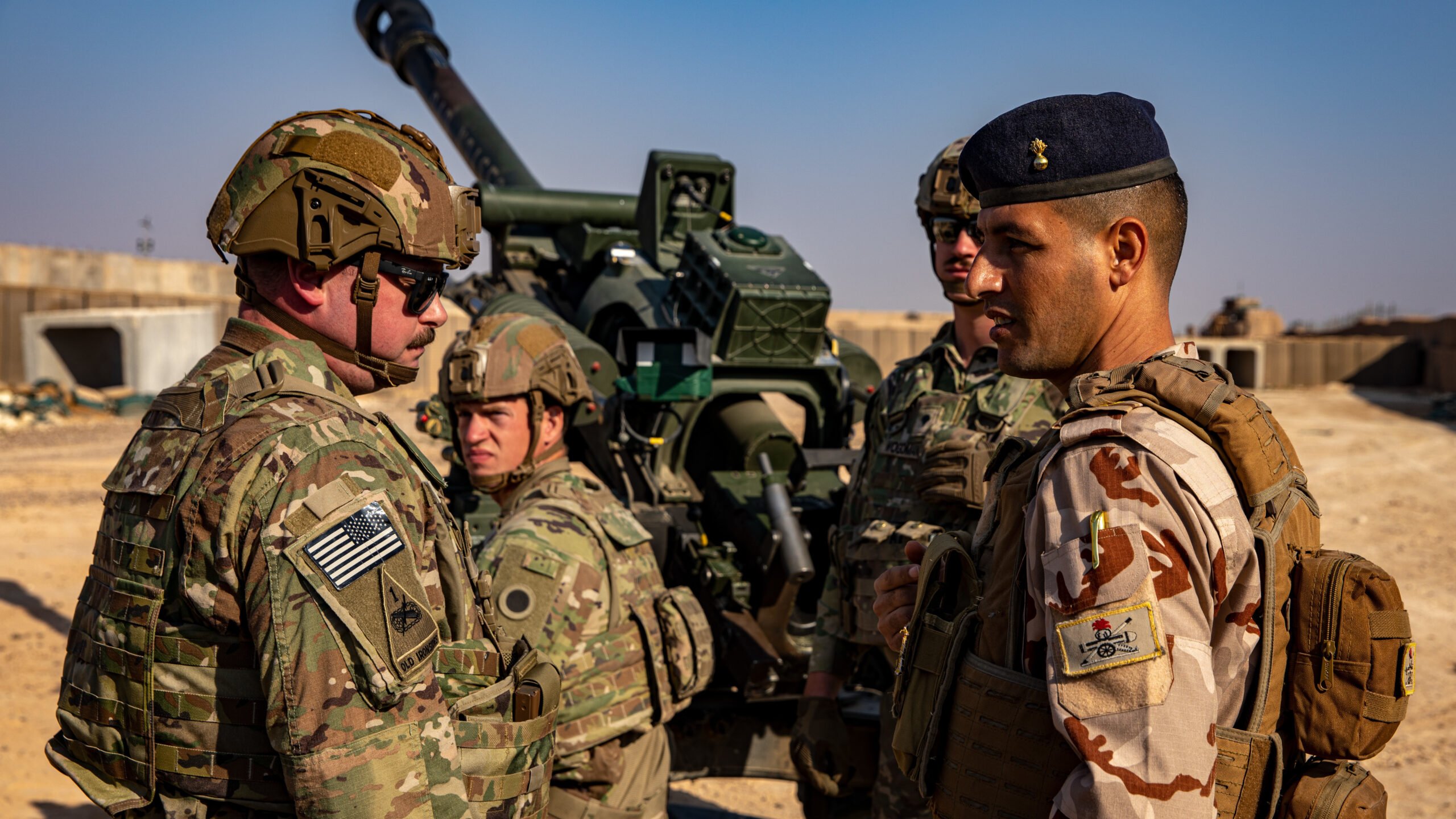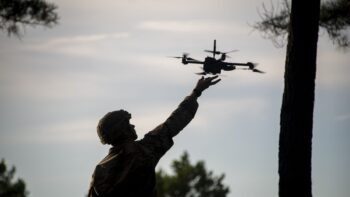JONATHAN LORD

U.S. Army Capt. Robert McClurg, assigned to Headquarters and Headquarters Battery, 1st Battalion, 134th Field Artillery Regiment, 37th Infantry Brigade Combat Team, discusses with an Iraqi army Solider, Al Asad Air Base, Iraq, Feb. 27, 2023. (U.S. Army photo by Sgt. Julio Hernandez)
Since 2014, the US has poured millions of dollars into Iraq under the mission of defeating ISIS. Even as the threat has shrunk, argues Jonathan Lord of the Center for a New American Security, the funding has continued with little to no change in approach. With a meeting of key officials in Washington this week, Lord says, it is time to reassess.
This week, the Pentagon will host Iraq’s Defense Minister Thabet Muhammad al-Abbasi and a delegation of Iraqi military leaders, selected by Iraqi Prime Minister Mohammed Shia al-Sudani, for a Joint Security Cooperation Dialogue (JSCD) in Washington. The two-day conference, led on the American side by Assistant Secretary of Defense for International Security Affairs Celeste Wallander, will seek to discern a vision for the future of the US-Iraqi security relationship.
It’s a discussion that’s long overdue, and one that has to come with hard questions, not just about US-Iraq affairs but about how the Biden administration plans to manage the millions of dollars it still spends on Iraqi security each year.
Since 2014, when the US military returned to Iraq under the auspices of Operation Inherent Resolve (OIR), its mission and legal authorities have focused squarely on defeating ISIS — which at the time controlled one-third of the country, and was closing in on Baghdad and Erbil. The Iraqi security forces (ISF) and the Kurdish Peshmerga were in various stages of collapse and retreat, respectively. Dormant militias, with backing from Iran and harnessing a twisted interpretation of a fatwa from Iraq’s most senior Shia cleric, were re-establishing their ranks to fight-off the coming ISIS hordes. Iraq’s Counterterrorism Service, which had the longest, continuous relationship with its American counterparts of any Iraqi unit, remained one of the few relatively-capable forces, and found itself on the vanguard of virtually every significant and successful Iraqi operation to claw back territory from ISIS.
Through the first three phases of the campaign, the Pentagon worked with Iraq’s military forces (all but the Popular Mobilization Forces, which it was precluded from supporting due to its proximity and linkages with Iran) to flood the zone with arms, equipment, and training. That included thousands of precision-guided munitions, as well as intelligence, surveillance, and reconnaissance (ISR), courtesy of constant coverage from US Air Force UAVs.
As early as 2017, after ISIS’ last major bastion of Mosul was liberated, Central Command planners began cogitating over what conditions needed to be met in order to reach “Phase IV” of the operation, and its ultimate conclusion. Nine years (to the day, August 8) since OIR began, it continues to languish in its final phase, which began in 2020, when a global pandemic reduced any in-person US-Iraqi mil-to-mil engagement to nil. Though ISIS has been reduced to an insurgent nuisance, OIR has persisted, as has the Congressional authority and funds to train and equip Iraqi forces that have long been saturated with equipment and training by their US counterparts.
The Biden administration, the third US presidential administration to oversee OIR, has not moved with any particular urgency to advance beyond the defeat-ISIS mission. In July 2021, during a bilateral “strategic dialogue” with a delegation of Iraqi leaders, President Joe Biden announced the end of US combat operations in Iraq, and the withdrawal of any remaining combat forces by year’s end. The move was largely gestural, as US forces hadn’t suffered a single casualty in battle with ISIS since 2019.
Today, the US military presence is largely confined to an advisory role in operational control rooms managed by Iraqi forces. Most of the resources it is appropriated and authorized by Congress in the “Counter-ISIS Train and Equip Fund” (CTEF) no longer pay for the rapid acquisition of vehicles, guns, and munitions. Instead, they are mostly used to pay the salaries of a teetering and largely symbolic force of Kurdish Peshmerga, the “Regional Guard Brigades” (RGBs), drawn together from the Kurdistan region’s two major political factions. The RGBs remain one of Iraq’s shakiest forces, perhaps even a “Potemkin Village” which the Kurdistan Regional Government props up to ensure the continued flow of tens of millions of dollars of support every month.
Plainly put: Year in and year out, the Department of Defense has continued to request funding and the extension of authorities from Congress to train Iraqi forces to fight ISIS ($315 million this fiscal year alone), despite the fact that OIR’s training activities in Iraq have long since ceased and the fight is nearly non-existent.
Why This Week’s Meetings Matter
“Lasers are complicated. This is not a humvee that’s sitting in the motor pool,” said Lt. Gen. Daniel Karbler.
This week’s JSCD is the long-awaited kick-off to a bilateral discussion of what should come next. Why it has taken so long to reach this point is a question the Pentagon should have to answer.
Lawmakers have been calling for such a dialogue — in law — as early as 2019, when in the Fiscal Year 2020 National Defense Authorization Act, Congress held back funding until the Defense Department took steps to properly staff the US Embassy-based “Office of Security Cooperation-Iraq,”, appoint a “Senior Defense Official-Defense Attache” (SDO-DATT), and host a “bilateral engagement with the Government of Iraq with the objective of establishing a joint mechanism for security assistance planning, including a five-year security assistance roadmap for developing sustainable military capacity and capabilities and enabling defense institution building and reform.”
The Pentagon appointed an SDO-DATT a few years ago, though to this day, hasn’t provided permanent billets for OSC-I staff, despite Congress having mandated (and annually-restating the mandate for such) reform for years. The foot-dragging hasn’t come without cost or waste.
The Pentagon continues to spend upwards of $20 million every month to prop-up an Iraqi Kurdish force that will likely disintegrate the day the money dries up. Having spent billions of dollars to arm Iraq for the ISIS fight, little effort has been made to reform Iraqi defense institutions, such that it can sustain its own equipment, plan and execute its own operations, operate without US-provided intelligence and ISR, or effectively command and maneuver combined forces on the field of battle. In essence, all of the ills that plagued the Iraqi military in 2014 still do, which makes sense, since virtually none of our military support was focused on fixing that problem. The focus was, rightly, on defeating ISIS.
Frustration and concern has mounted in Congress. In posture hearings this year, when asked about the future of Iraq, Secretary of Defense Lloyd Austin’s answer was to assure members of Congress that the US military was staying-put. Wrong answer. Congress has sought to understand what steps the Pentagon was undertaking such that Iraq might no longer need to rely on an outsized US military presence, which itself has been the subject of constant political debate in Baghdad. While no US servicemembers have died at the hands of ISIS since 2019, some have been killed more recently than that, as the result of attacks by Iran-supported militias that violently object to a continued US military presence on Iraqi soil.
Unwilling to wait any longer for the Pentagon to drive a future policy, the FY22 NDAA included line-item funding for Iraq under the less-permissive 10 USC 333 security cooperation authority, which would enable greater oversight of the US military’s security cooperation than the emergency ISIS authorities. Unlike the ISIS train and equip authority, “333” (“triple 3,” as it’s known) focuses more on building lasting military capacity, which is sorely needed if the ISF is to avoid repeating the history of collapse it suffered in 2014.
In addition to brain-storming what funds and authorities it needs to assist Iraq’s military forces into the future, the Pentagon needs to coordinate its effort with the State Department, which through Title 22-based foreign military financing, continues to support major Iraqi military weapons programs that the Iraqi MoD will almost certainly never be able to sustain without help.
Does Iraq need F-16s, which are expensive to fly and maintain, or might there be a more appropriate solution to provide Iraq’s ground forces with the air support they need? What about the C-130s or the M1 Abrams tanks? If these platforms are important enough to Iraq’s MoD, will it budget the necessary funds to pay for their upkeep, or is the US taxpayer going to foot the bill in perpetuity? The Pentagon and State Department need to come to a shared vision of future US military support, and it must do so collaboratively with Iraq’s military and political leaders, if they are to be effective.
The Iraqis too have hard choices to make. It will require immense political will and courage to reform an Iraqi defense establishment that continues to perpetually hollow itself through corruption, indifference, and over-dependence on foreign assistance. It will require Prime Minister Sudani to ultimately confront and rein in para-military forces that exert too much political power, answer to too many commanders that aren’t him, and extract too many resources from Iraq’s government, for too-little security benefit for Iraqis. It will require Iraqi Kurdish leaders to commit to meaningful reform of the Peshmerga, such that it’s no longer the arm of political factions, but rather a tool of state security that’s answerable to elected leaders. It must operate to secure the safety and future of all Iraqi Kurds, in coordination with federal Iraq as a partner, and not be abused by individual Kurdish leaders for their own power and enrichment.
With any hope, this JSCD is the first step in achieving a shared vision of a US-Iraqi security relationship that closes the book on the ISIS fight and develops an Iraqi military partner that can stand on its own two feet with fewer commitments in US blood and treasure. Though by any measure, it’s a hard step, it’s necessary, long overdue, and a more-than-welcome development.

No comments:
Post a Comment